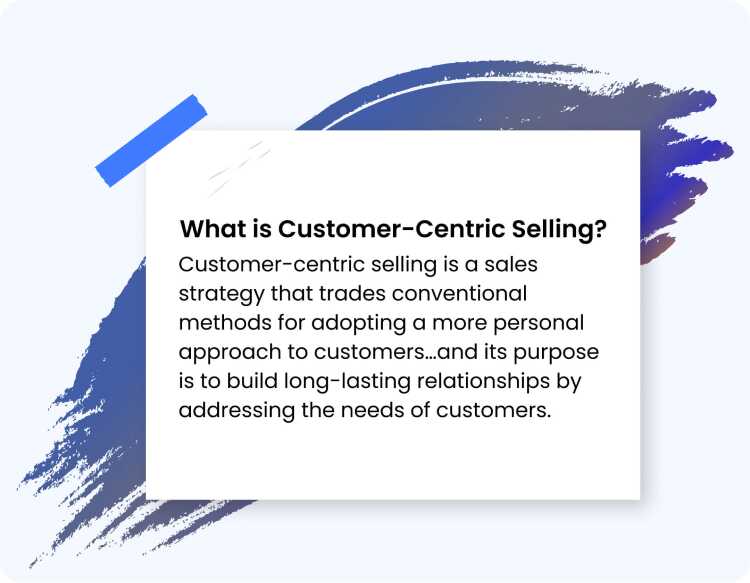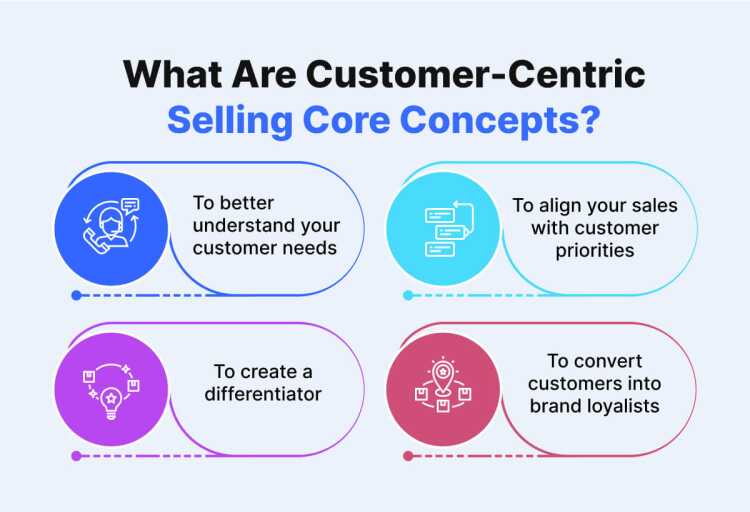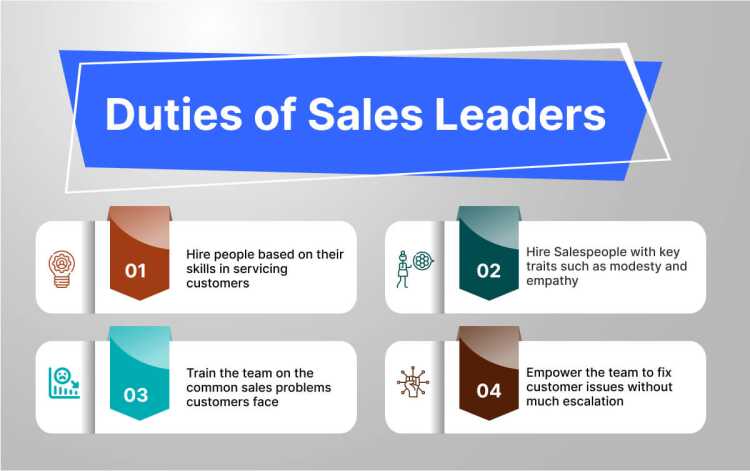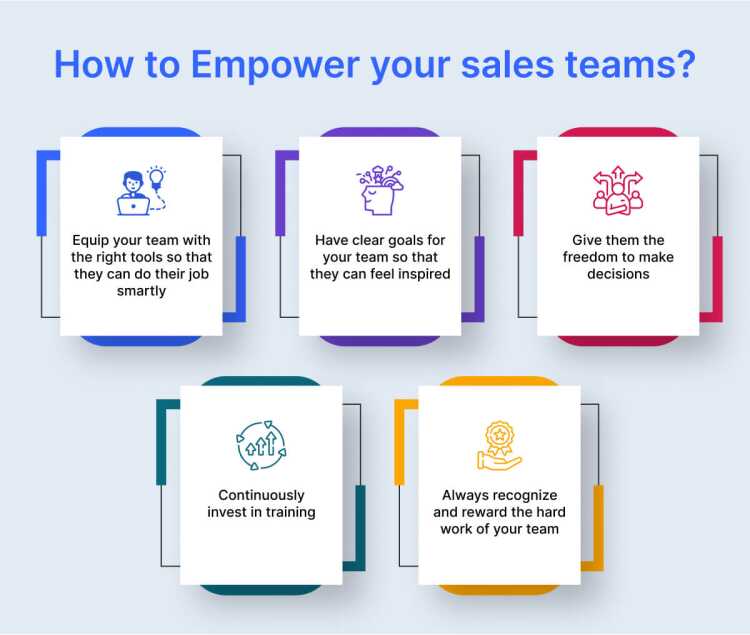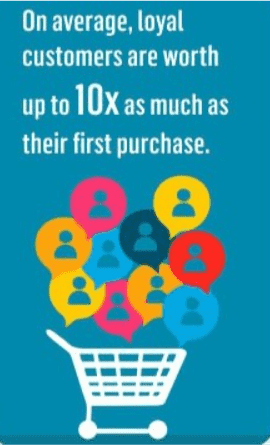When it comes to sales, the old rules don’t work anymore. They don’t work anymore because the rules have changed a bit. Now, customers are more in control of things than ever before and they like to dictate terms. Maybe that’s why companies that continue to play the games by the old rules of sales are finding the going a bit tough.
In fact, a lot of companies make this mistake where they give sales the maximum focus and ignore customer satisfaction. But this approach feels out of place simply because customers have evolved. So, sales now has to be all about putting your customers first! It also means you need to adopt a customer-centric selling approach.
Your sales strategy also needs to be aligned with the continuously changing landscape of digital technology that is giving customers more options than ever before. Your approach to sales needs to change as well with a focus to serve customers rather than earn a profit from them.
In this type of selling, the real emphasis has to be on elevating the people who matter the most, building long-term relationships, and ensuring great experiences. And if all this is done, sales will automatically take care of themselves.
This post will explore everything about customer-centric selling, including its definition, significance, methodology, and examples.
What is Customer Centric Selling?
Customer-centric selling is an innovative sales strategy that trades conventional methods for adopting a more personal approach toward customers. Unlike the old method where promoting the product was the main focus, here the ultimate goal is to build long-lasting relationships by addressing the needs of customers.
When the sales process is customer-centric, it means the real concern of the company is geared toward asking the right questions and identifying pain points to ensure great experiences. In this type of selling, a seller aims to elevate the customer and empathize with their needs at every stage of the sales process.
Helping people, nurturing the customers, and adjusting the sales process to the needs of the target audience are the main reasons behind the advent of this form of selling.
What Are Customer-Centric Selling Core Concepts?
Customers should come first. And the companies that adopt this approach witness benefits to the bottom line. In fact, 89% of consumers are more likely to return back again for another purchase if they have received a positive service experience the first time around. So, the core concepts of customer-driven selling come down to aligning your sales strategy in tune with the needs of customers.
Key customer-centric selling core concepts include –
- To better understand your customer needs – You may lose sight of what customers really want when your focus is too much on the product and its sales. And with this approach, you may risk losing your customers as well. On the other hand, when your real concern is meeting the specific needs of the customers, not only your sales process does better but it also improves the profits.
- To align your sales with customer priorities – Successful enterprises understand the value of aligning their sales process with customer priorities. They realize the significance of tweaking the sales process in a way that prioritizes customers and helps them achieve their goals with the business.
- To create a differentiator – Not many businesses are adopting customer-oriented sales and most of them are focused more on short-term gains to lose focus of what lies in the long run. But when your company emphasizes more on building long-term relationships, offering great experiences, and solving problems, it helps create a differentiator for your business.
- To convert customers into brand loyalists – Companies that bother to listen to customer needs, solve their problems, and enhance their experience every step of the way have more brand loyalists. They know the importance of relying on a customer-centric selling process to convert customers into brand loyalists forever.
Benefits of Adopting a Customer-Centric Selling Approach
Customers love being cared for. They also like being pampered. And when a brand takes care of its customers, meets their needs, cares for them, and pampers them, the effects are visible.
Adopting a customer-centric selling approach can ensure a range of benefits on many different fronts, including,
- Improved customer satisfaction – Sales is much more than just a transaction. It’s also about providing solutions that meet customers’ specific needs. And when that happens, the satisfaction level for customers goes up.
- Higher conversion rates – No matter how innovative a sales strategy your business uses, it can’t do much if it’s not aimed at elevating customers’ experience with the brand. But when great customer experience is delivered, it always ensures higher conversation rates.
- Increased revenue – When your sales process is tailored to add value, it leads to happy customers. And when customers are happy, revenue is bound to increase over time.
- Boost to brand reputation – Adopting a customer-centric approach means taking care of customer satisfaction at every stage of the journey and never compromising on quality. All this gives a boost to the brand’s reputation.
Tips to Build and Implement A Customer-Centric Selling Process
Over the years, selling approaches have undergone a sea change with the focus shifting from products to customers. And now when digital technology is evolving at a rapid rate, it’s obvious to see how brands are changing their sales processes to allow more flexibility and options to customers. This is like taking a gradual step towards customer-centricity and making the sales more value-driven and long-term.
Here are some key tips to implement a customer-centric selling process-
1. Hire and Train Salespeople with the Right Skills
Most sales leaders hire people based on their sales skills, which is quite understandable. After all, only sales can keep the wheels of an organization running, right? But the problem pops up when the very salespeople fail to convert customers into loyalists as doing this involves a very different set of skills. Sales skills won’t help here.
So, it’s the job of a sales leader to not only hire the right people but also train the existing team to inculcate in them the virtues of helping customers. And helping customers means looking at them not from the sales point of view, but from the value point of view.
Sales leaders should ensure that –
- Salespeople are hired based on their skills in servicing customers
- Salespeople have key traits such as modesty and empathy
- The team is trained on the common sales problems customers face
- Empower the team to not only fix customer issues but also elevate their experience with the brand
2. Focus on Long-Term Relationships
Sales should never be a short-term endeavor. Rather, for both, customers as well as brands, it should always be a long-term association. And that can happen only when salespeople are trained in handling customers and understanding their requirements better.
When the focus of your sales process is long-term, you can build more mutually rewarding relationships with customers. You can foster trust and solve specific problems. With this kind of approach, your sales team will look to help customers navigate their journey with improved experience at every stage.
Focusing on long-term relationship-building means –
- Your team needs to be service-oriented rather than sales-driven
- You need to listen to your customers, seek their feedback, and implement the changes
- You need to provide more personalized solutions to make customers feel valued and happy
3. Listen to Your Customers
Listening to your customers is one of the pillars of a customer-centric selling culture. When you listen, it means you’re ready to have conversations with them. And these conversations can help you understand what customers exactly need, what they expect of your product, and how they feel about your business.
When salespeople are ready to listen to the customer, they are more likely to be aware of the specific situations and problems customers might be dealing with. This is when customers’ individual needs are best understood and great experiences are delivered.
To listen to your customers, you can –
- Run timely surveys and gather feedback
- Be active on social media and other channels to engage with customers
- Encourage customers to share their problems so that you can improve your products and experience as well
4. Empower Your Sales Teams
Salespeople are not robots. They may be great at closing out deals for your business but their motivation level can wane if they don’t feel inspired. But when they do, they are always more effective and efficient in their roles. And we know how an empowered team is always an inspired team!
Some of the ways to empower your sales team can be –
- Equip your team with the right tools so that they can do their job smartly
- Have clear goals for your team so that they can feel inspired to achieve that
- Give them the freedom to make decisions and solve customer issues without much escalation
- Continuously invest in training and always recognize their hard work
5. Work on Customer Engagement
Engagement is often the first step to sales. And if your business is able to engage customers better, it can always enjoy improved sales. After all, 86% of customers can pay more for better service. The good thing, there is a wide range of customer engagement tools that your business can leverage and drive sales.
These tools are very valuable for supporting customers through their digital journey, helping them at each stage, and delivering great experiences as well. Some of these tools also provide customer-centric data that can be used for making informed decisions.
These engagement tools you should benefit from –
- Live Chat – You can provide real-time quick and convenient support using live chat and help customers 24×7. The use of live chat can ensure improved customer satisfaction, resulting in more conversions and sales.
- Chatbot – AI chatbots can be used not only to engage customers but also to drive the rate of engagement. Using a chatbot, you can automate various tasks across sales, marketing, and support and drive the rate of conversions.
6. Reward Customer Loyalty
When your sales strategy is customer-centric, you will obviously get the kind of sales you anticipate. And when sales happen, your focus should always be on ensuring that customers stick. So, you would need to take steps that get customers to keep coming back for more. And this is where rewarding customer loyalty matters.
Rewarding customer loyalty can benefit your business in many ways, including –
- It will make customers stay with your brand for longer, therefore reducing the need to spend on acquiring new customers.
- Happy customers can refer your brand to others.
- When customers are rewarded, they are more likely to make repeat purchases.
The good thing, it does not cost much to reward your loyal customers. You can achieve that target in many different ways like you can offer special discounts, send gifts, or run loyalty programs, or offer personalized, experiences, etc.
Great Examples of Customer Selling Approach
A lot of brands are getting their sales approach right and winning the trust and loyalty of their customers. Some of them are expert at understanding customer motivation as well. Among many examples, the ones of Amazon and Apple stand out for many reasons.
Apple – In the business world, there can’t be a better example than Apple for a customer-centric selling approach. The company trains salespeople to listen to customer needs, understand their problems, and then offer help in the form of the latest product. Their sales teams are also trained to make recommendations so that customers’ specific needs can be met.
Amazon – Quite like Apple, Amazon too is kind of a pioneer of a customer-centric approach but in the e-commerce space. When you shop at their store, you will get personalized recommendations based on your browsing and purchasing history. More importantly, their customer service team is always there 24/7 to help you with any issues. On top of that, they have free shipping and easy returns.
Use REVE Chat Tools and Boost Customer-Centric Selling Approach
Winning customers’ trust is easier said than done. And unless your company is customer-centric, you’re not going to win that trust.
We, at REVE Chat, understand how important it’s for businesses to not only provide great experiences for customers but also drive conversions.
Our customer engagement tools will help your business a lot in the digital sales journey and equip you to serve customers well.
Your business can leverage our AI-powered chatbot and automate key tasks across sales and marketing.
Other tools like video chat and co-browsing software can also prove very handy in boosting the engagement level with customers.
Similarly, the use of our live chat software can help you provide quick support to website visitors and convert them into prospects.
Final Thoughts
Customer expectations are changing by the day and your selling approach too should keep pace with the time. And now when customers are dictating terms, make sure your selling process respects that sentiment and gives buyers the kind of choices they are accustomed to getting these days.
To make your selling process truly customer-centric, you may also need a range of engagement tools so that your salespeople feel empowered.
You can sign up and check out some top tools for driving your engagement which can drive sales as well.

